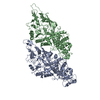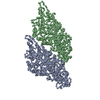+ Open data
Open data
- Basic information
Basic information
| Entry | Database: PDB / ID: 7ns2 | ||||||
|---|---|---|---|---|---|---|---|
| Title | Virion of Leishmania RNA virus 1 | ||||||
 Components Components | Capsid protein | ||||||
 Keywords Keywords | VIRUS / Leishmania guyanensis / native virion structure / mucocutaneous leishmaniasis / Totiviridae | ||||||
| Function / homology | Totivirus coat / Totivirus coat protein / Capsid protein Function and homology information Function and homology information | ||||||
| Biological species |  Leishmania RNA virus 1 - LgM5313 Leishmania RNA virus 1 - LgM5313 | ||||||
| Method | ELECTRON MICROSCOPY / single particle reconstruction / cryo EM / Resolution: 3.63 Å | ||||||
 Authors Authors | Prochazkova, M. / Grybchuk, D. / Fuzik, T. | ||||||
| Funding support |  Czech Republic, 1items Czech Republic, 1items
| ||||||
 Citation Citation |  Journal: Virology / Year: 2022 Journal: Virology / Year: 2022Title: Virion structure of Leishmania RNA virus 1. Authors: Michaela Procházková / Tibor Füzik / Danyil Grybchuk / Vyacheslav Yurchenko / Pavel Plevka /  Abstract: The presence of Leishmania RNA virus 1 (LRV1) enables Leishmania protozoan parasites to cause more severe disease than the virus-free strains. The structure of LRV1 virus-like particles has been ...The presence of Leishmania RNA virus 1 (LRV1) enables Leishmania protozoan parasites to cause more severe disease than the virus-free strains. The structure of LRV1 virus-like particles has been determined previously, however, the structure of the LRV1 virion has not been characterized. Here we used cryo-electron microscopy and single-particle reconstruction to determine the structures of the LRV1 virion and empty particle isolated from Leishmania guyanensis to resolutions of 4.0 Å and 3.6 Å, respectively. The capsid of LRV1 is built from sixty dimers of capsid proteins organized with icosahedral symmetry. RNA genomes of totiviruses are replicated inside the virions by RNA polymerases expressed as C-terminal extensions of a sub-population of capsid proteins. Most of the virions probably contain one or two copies of the RNA polymerase, however, the location of the polymerase domains in LRV1 capsid could not be identified, indicating that it varies among particles. Importance. Every year over 200 000 people contract leishmaniasis and more than five hundred people die of the disease. The mucocutaneous form of leishmaniasis produces lesions that can destroy the mucous membranes of the nose, mouth, and throat. Leishmania parasites carrying Leishmania RNA virus 1 (LRV1) are predisposed to cause aggravated symptoms in the mucocutaneous form of leishmaniasis. Here, we present the structure of the LRV1 virion determined using cryo-electron microscopy. #1:  Journal: J Virol / Year: 2021 Journal: J Virol / Year: 2021Title: Capsid Structure of Leishmania RNA virus 1 Authors: Prochazkova, M. / Fuzik, T. / Grybchuk, D. / Falginella, F.L. / Podesvova, L. / Yurchenko, V. / Vacha, R. / Plevka, P. | ||||||
| History |
|
- Structure visualization
Structure visualization
| Structure viewer | Molecule:  Molmil Molmil Jmol/JSmol Jmol/JSmol |
|---|
- Downloads & links
Downloads & links
- Download
Download
| PDBx/mmCIF format |  7ns2.cif.gz 7ns2.cif.gz | 224.6 KB | Display |  PDBx/mmCIF format PDBx/mmCIF format |
|---|---|---|---|---|
| PDB format |  pdb7ns2.ent.gz pdb7ns2.ent.gz | 178.1 KB | Display |  PDB format PDB format |
| PDBx/mmJSON format |  7ns2.json.gz 7ns2.json.gz | Tree view |  PDBx/mmJSON format PDBx/mmJSON format | |
| Others |  Other downloads Other downloads |
-Validation report
| Summary document |  7ns2_validation.pdf.gz 7ns2_validation.pdf.gz | 1 MB | Display |  wwPDB validaton report wwPDB validaton report |
|---|---|---|---|---|
| Full document |  7ns2_full_validation.pdf.gz 7ns2_full_validation.pdf.gz | 1.1 MB | Display | |
| Data in XML |  7ns2_validation.xml.gz 7ns2_validation.xml.gz | 49.5 KB | Display | |
| Data in CIF |  7ns2_validation.cif.gz 7ns2_validation.cif.gz | 74.5 KB | Display | |
| Arichive directory |  https://data.pdbj.org/pub/pdb/validation_reports/ns/7ns2 https://data.pdbj.org/pub/pdb/validation_reports/ns/7ns2 ftp://data.pdbj.org/pub/pdb/validation_reports/ns/7ns2 ftp://data.pdbj.org/pub/pdb/validation_reports/ns/7ns2 | HTTPS FTP |
-Related structure data
| Related structure data |  12558MC  7z90C M: map data used to model this data C: citing same article ( |
|---|---|
| Similar structure data | Similarity search - Function & homology  F&H Search F&H Search |
- Links
Links
- Assembly
Assembly
| Deposited unit | 
|
|---|---|
| 1 | x 60
|
- Components
Components
| #1: Protein | Mass: 86431.742 Da / Num. of mol.: 2 / Source method: isolated from a natural source / Source: (natural)  Leishmania RNA virus 1 - LgM5313 / References: UniProt: L7XUU7 Leishmania RNA virus 1 - LgM5313 / References: UniProt: L7XUU7Has protein modification | Y | |
|---|
-Experimental details
-Experiment
| Experiment | Method: ELECTRON MICROSCOPY |
|---|---|
| EM experiment | Aggregation state: PARTICLE / 3D reconstruction method: single particle reconstruction |
- Sample preparation
Sample preparation
| Component | Name: Leishmania RNA virus 1 / Type: VIRUS / Entity ID: all / Source: NATURAL | |||||||||||||||
|---|---|---|---|---|---|---|---|---|---|---|---|---|---|---|---|---|
| Molecular weight | Value: 9.1 MDa / Experimental value: NO | |||||||||||||||
| Source (natural) | Organism:  Leishmania RNA virus 1 / Strain: 1-4 Leishmania RNA virus 1 / Strain: 1-4 | |||||||||||||||
| Details of virus | Empty: YES / Enveloped: NO / Isolate: STRAIN / Type: VIRION | |||||||||||||||
| Natural host | Organism: Leishmania guyanensis / Strain: MHOM/BR/75/M4147 | |||||||||||||||
| Virus shell | Name: capsid / Diameter: 421 nm / Triangulation number (T number): 2 | |||||||||||||||
| Buffer solution | pH: 7.4 / Details: pH 7.4 | |||||||||||||||
| Buffer component |
| |||||||||||||||
| Specimen | Conc.: 15 mg/ml / Embedding applied: NO / Shadowing applied: NO / Staining applied: NO / Vitrification applied: YES / Details: Buffer: 50 mM HEPES pH 7.4, 150 mM NaCl | |||||||||||||||
| Specimen support | Grid material: COPPER / Grid mesh size: 300 divisions/in. / Grid type: Quantifoil R2/1 | |||||||||||||||
| Vitrification | Instrument: FEI VITROBOT MARK II / Cryogen name: ETHANE-PROPANE / Humidity: 70 % / Chamber temperature: 295 K |
- Electron microscopy imaging
Electron microscopy imaging
| Experimental equipment |  Model: Titan Krios / Image courtesy: FEI Company |
|---|---|
| Microscopy | Model: FEI TITAN KRIOS |
| Electron gun | Electron source:  FIELD EMISSION GUN / Accelerating voltage: 300 kV / Illumination mode: FLOOD BEAM FIELD EMISSION GUN / Accelerating voltage: 300 kV / Illumination mode: FLOOD BEAM |
| Electron lens | Mode: BRIGHT FIELD / Nominal magnification: 105000 X / Nominal defocus max: 5000 nm / Nominal defocus min: 3500 nm / Alignment procedure: COMA FREE |
| Specimen holder | Cryogen: NITROGEN / Specimen holder model: FEI TITAN KRIOS AUTOGRID HOLDER |
| Image recording | Electron dose: 1.3 e/Å2 / Detector mode: SUPER-RESOLUTION / Film or detector model: GATAN K2 SUMMIT (4k x 4k) / Num. of grids imaged: 1 / Num. of real images: 3981 |
| Image scans | Movie frames/image: 40 |
- Processing
Processing
| EM software |
| ||||||||||||||||||||||||||||||||
|---|---|---|---|---|---|---|---|---|---|---|---|---|---|---|---|---|---|---|---|---|---|---|---|---|---|---|---|---|---|---|---|---|---|
| CTF correction | Type: PHASE FLIPPING AND AMPLITUDE CORRECTION | ||||||||||||||||||||||||||||||||
| Particle selection | Num. of particles selected: 7912 | ||||||||||||||||||||||||||||||||
| Symmetry | Point symmetry: I (icosahedral) | ||||||||||||||||||||||||||||||||
| 3D reconstruction | Resolution: 3.63 Å / Resolution method: FSC 0.143 CUT-OFF / Num. of particles: 3768 / Algorithm: FOURIER SPACE / Num. of class averages: 1 / Symmetry type: POINT | ||||||||||||||||||||||||||||||||
| Atomic model building | B value: 72.61 / Protocol: RIGID BODY FIT / Space: RECIPROCAL / Target criteria: correlation coefficient | ||||||||||||||||||||||||||||||||
| Atomic model building | PDB-ID: 6Y83 Pdb chain-ID: A / Accession code: 6Y83 / Source name: PDB / Type: experimental model | ||||||||||||||||||||||||||||||||
| Refinement | Highest resolution: 3.63 Å |
 Movie
Movie Controller
Controller






 PDBj
PDBj